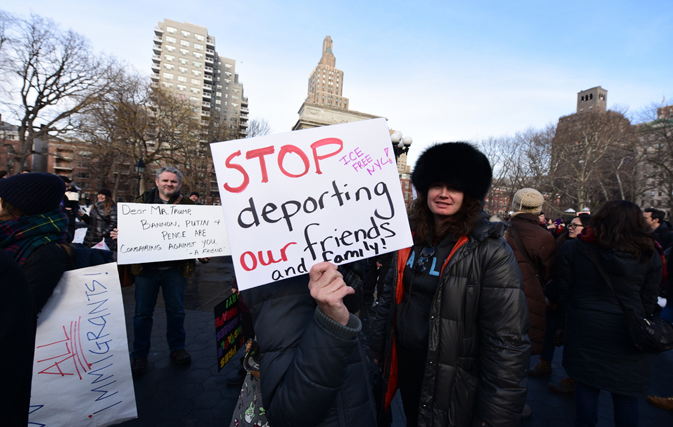WASHINGTON — U.S. President Trump says his administration is taking “new steps” to keep the U.S. safe – “and to keep out those who would do us harm.” Most believe those steps will include a new revamped travel ban, possibly handed down as early as this week.
Trump’s initial action, issued Jan. 27, temporarily barred citizens of Iran, Iraq, Syria, Yemen, Somalia, Sudan and Libya from coming to the U.S. and halted acceptance of all refugees. The new order was expected as soon as Wednesday. A draft suggested it would target people from the same seven predominantly Muslim countries but would exempt travellers who already have visas to come to the U.S.
The first order was met by legal challenges, confusion at airports and mass protests. The White House has forecast smoother sailing the second time around. White House press secretary Sean Spicer predicted last week “it will be implemented flawlessly” because of the due diligence of officials.
But no matter what the new policy says, lawsuits challenging its aims are expected. Airport officials and civil rights lawyers around the country are getting ready for a new travel ban, mindful of the chaos that accompanied the initial executive order but hopeful the forthcoming version will be rolled out in a more orderly way.
Since last month’s ban, which courts have put on hold, a section of the international arrivals area at Dulles International Airport outside the nation’s capital has been transformed into a virtual law firm, with legal volunteers ready to greet travellers from affected countries and ask if they saw anyone being detained.
Similar efforts are underway at other airports, including Seattle-Tacoma International, where officials have drawn up plans for crowd control after thousands crammed the baggage claim area to protest the original ban.
“The plan is to be as ready as possible,” said Lindsay Nash, an immigration law professor at Cardozo School of Law in New York who has been helping prepare emergency petitions on behalf of those who might be detained.
Many civil rights lawyers and activists have said they don’t believe a new order would cure all the constitutional problems of the original, including the claim that it was motivated by anti-Muslim discrimination.
Trump has said he singled out the seven countries because they had already been deemed a security concern by the Obama administration.
Questions and answers about the path ahead:
When is the order coming, and what will it say?
The White House says it expects to issue a new order this week. Trump aide Stephen Miller said at a Fox News town hall last week that the new order would be very similar to the first, with “mostly minor technical differences” in response to opinions by judges who have blocked it.
The Justice Department has said the Trump administration would be abandoning the original order, which should render moot ongoing court challenges to that order. But the president and the White House press secretary have also recently said that they intend to fight for the merits of the original order in court, even as they draft a replacement.
On Monday, the San Francisco-based 9th U.S. Circuit Court of Appeals denied a request from the Justice Department to put Trump’s travel ban case on hold until he issues a new order.
The new order could go into effect immediately and would not be blocked by the court ruling that has kept the existing order on hold, said David Levine, a professor at the University of California, Hastings College of the Law in San Francisco. Levine said new regulations and laws are assumed to be legal until a court says otherwise. “It’s valid unless it’s invalid,” Levine said.
Can we expect court challenges to the new order?
Yes. The new order could potentially remove Iraq from the list of countries facing a temporary U.S. travel ban. Citing the latest draft in circulation, and according to reports, the document also no longer singles out Syrian refugees for an indefinite ban and instead includes them in a general, 120-day suspension of new refugee admissions. The new order reportedly maintains the ban for the other six countries – Iran, Libya, Somalia, Syria, Sudan and Yemen.
It’s hard to imagine a “bulletproof” order that could assuage the concerns of the immigrant rights community and other potential challengers, said Jon Michaels, a UCLA law professor.
“My sense is, there will be challenges, and challenges will be, at the very least, plausible challenges,” Michaels said.
A repeat of the chaos that the original order sparked is possible, said University of Texas law professor Stephen Vladeck. “It will surely be a mess,” he said. But the administration insists that won’t be the case.
Spicer said last week the administration has “sought feedback and guidance and done this in an unbelievably comprehensive way” to make sure the agencies implementing the new order know what’s happening.
He said the administration is expecting potential new court challenges, but suggests the White House will be better prepared.
Will the new one pass constitutional muster?
That’s hard to say. The 9th Circuit decision, for instance, said the first order may have violated the constitutional rights of green-card holders to notice and a hearing before their travel was restricted. Any new policy may have to address that concern to be viable.
The Justice Department has argued that a ban that exempts green-card holders and focuses only on foreigners from the seven nations who have never entered the U.S. would be entirely legal. But the court said Washington state and Minnesota might have a valid claim that even some of those foreigners have a constitutional right to challenge the ban.
Foreigners outside the United States have, at best, limited rights to sue in U.S. courts.
